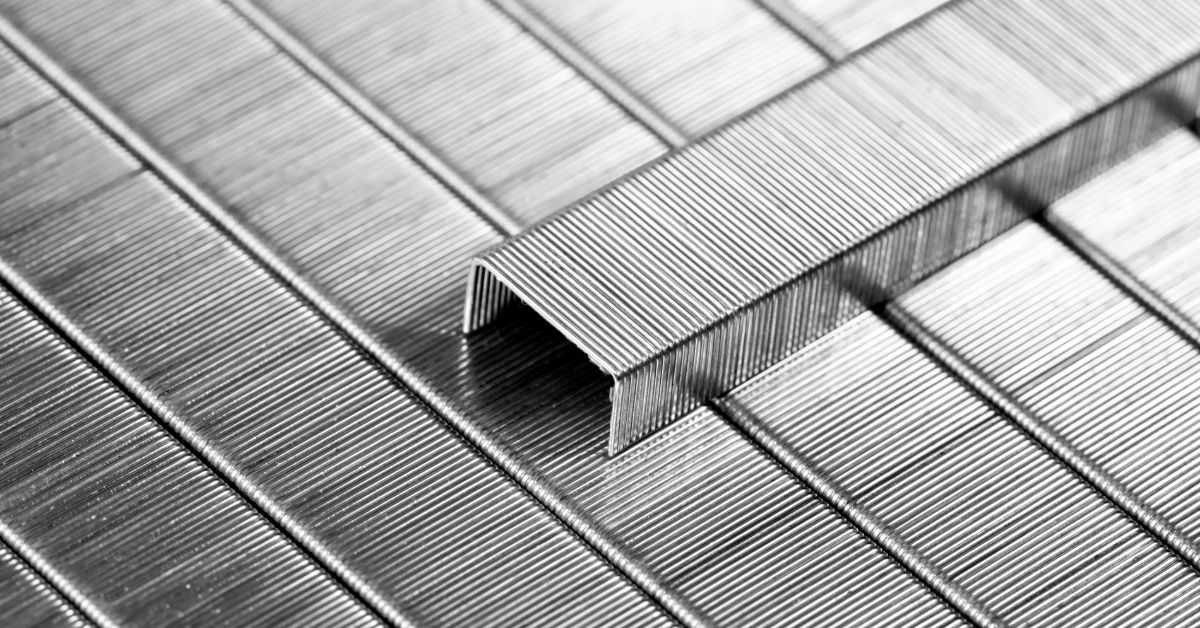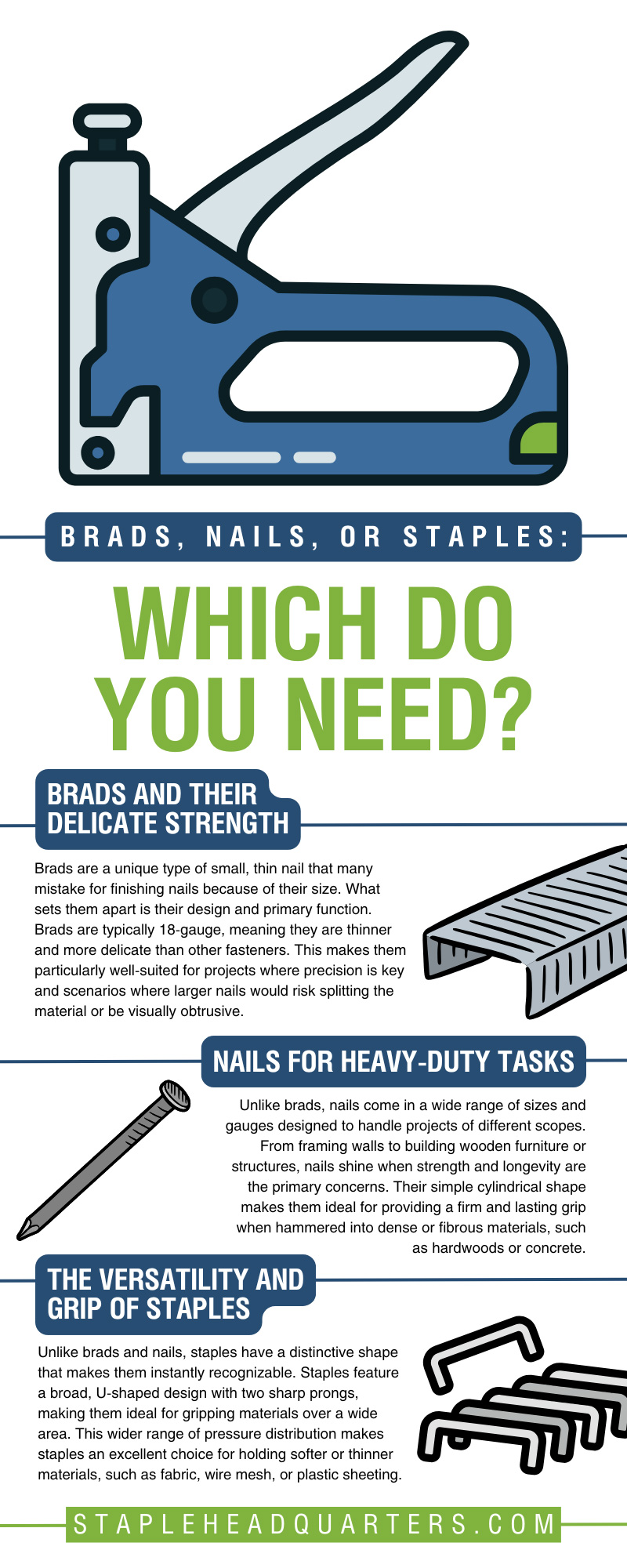
Choosing between brads, nails, or staples and understanding which one is needed can be confusing, especially for those new to woodworking, construction, or even simple DIY projects. While they all fall under the category of fasteners, their differences in design and function make it essential to pick the right one for your project. Our guide will walk you through their similarities and distinctions so that you can ensure your project turns out successful every time.
Understanding the Basics of Fasteners
To make the right decision, you need to understand what makes brads, nails and staples unique. Fasteners might all look similar at first glance, but each excels under particular circumstances. Brads are thinner and smaller, making them ideal for delicate work. Nails offer durability and strength for heavy-duty applications, while staples have a dual-pronged design that provides a firm grip over larger areas.
Understanding the core purpose of each will help you determine which one best fits your project’s needs. All three fasteners provide anchoring power, but their suitability depends on factors such as the material you’re working with, the force the fastener will endure, and aesthetic concerns.
Brads and Their Delicate Strength
Brads are a unique type of small, thin nail that many mistake for finishing nails because of their size. What sets them apart is their design and primary function. Brads are typically 18-gauge, meaning they are thinner and more delicate than other fasteners. This makes them particularly well-suited for projects where precision is key and scenarios where larger nails would risk splitting the material or be visually obtrusive.
For instance, brads are common in applications such as attaching trim or molding to walls or in carpentry projects. Their small heads make them almost invisible once driven into the material, achieving a seamless look that blends perfectly with painted or stained surfaces. Additionally, the small size of brads means they require less force to penetrate, which minimizes the risk of cracking wood or weakening delicate materials.
Nails for Heavy-Duty Tasks
Nails are perhaps the most widely recognized fastener around the world, largely due to their versatility and reliability. Whether you’re a professional contractor or a casual DIY enthusiast, nails have become the go-to choice for countless applications.
Unlike brads, nails come in a wide range of sizes and gauges designed to handle projects of different scopes. From framing walls to building wooden furniture or structures, nails shine when strength and longevity are the primary concerns. Their simple cylindrical shape makes them ideal for providing a firm and lasting grip when hammered into dense or fibrous materials, such as hardwoods or concrete.
Because they do not bend or loosen under sustained weight over time, nails are essential for projects where structural integrity is a must. However, because nails are so strong, they may leave noticeable marks or dimples on certain surfaces. This makes them less desirable for more delicate applications where visual aesthetics matter.
The Versatility and Grip of Staples
Unlike brads and nails, staples have a distinctive shape that makes them instantly recognizable. Staples feature a broad, U-shaped design with two sharp prongs, making them ideal for gripping materials over a wide area. This wider range of pressure distribution makes staples an excellent choice for holding softer or thinner materials, such as fabric, wire mesh, or plastic sheeting.
Another significant advantage of staples is their speed. Staple guns or pneumatic staplers enable projects to progress quickly, as they require less force to apply. This makes them a favorite among contractors or DIYers for tasks such as upholstering furniture, installing insulation, or even creating artistic displays with stretched canvas.
However, keep in mind that staples aren’t ideal for situations requiring structural durability. Because their grip is surface-level, they may not withstand heavy loads or significant wear and tear.
Choosing the Right Fastener for Any Project
Selecting the right fastener often depends not just on function but also on the project’s desired outcome. Consider the material you’re working with and whether it needs to endure weight or pressure. Additionally, consider whether the appearance of the fastener affects the overall aesthetic of the project.
For fine, intricate work where appearances matter, brads are the superior choice. For projects that require a long-term hold, such as construction or carpentry, nails are indispensable. If the need is for quick securing of materials or distributing force evenly across thin materials, then it’s best to use staples to bring utility and efficiency to the table.
Are you looking for a reliable and high-quality fastener and stapler store? Look no further than Salco! Whether you need heavy-duty staplers, fasteners, or specialized tools for your projects, Salco has you covered with a wide selection and unbeatable expertise. Explore our collection today!
Aligning Aesthetic Needs With Functionality
While functionality plays a critical role, the appearance of fasteners will matter. For example, in home remodels, visible nails on hardwood floors can stick out awkwardly. Brads would be a more fitting option here purely because of their subtlety. Similarly, for a custom-built fabric headboard, staples ensure that the material stays in place while maintaining a neat and consistent design.
Matching functionality with aesthetics ensures your finished piece not only performs well but also stands out as high-quality work, whether it’s decorative trim, a restored table, or a rustic fence panel.
When To Combine Fasteners for Best Results
Some projects require more flexibility and creativity, where combining two types of fasteners makes more sense. An example might be using nails to install a wooden frame but adding brads or staples for the finishing details. Mixing fasteners is not unusual in professional construction and can provide enhanced durability without sacrificing the fine-tuned appearance that a quality project demands.
Don’t forget to leverage tools like combination nail guns and staplers to make the process smoother and more convenient when managing multi-step tasks like this. There’s no need to limit yourself when craft artistry meets sturdy output.
Bringing Function and Aesthetics Together
Whether you’re revamping a home, crafting furniture, or working on personal DIY projects, choosing between brads, nails, or staples comes down to asking yourself, which one do you need? Understanding your material, end goals, and final product can help you choose the fasteners that align with your project.
There are multiple fastener options, and it can be overwhelming at first. However, by making the effort to understand these tools more clearly, you protect the outcome of your hard work and help your projects stand the test of time. Get started today by selecting the right tool for the task, and watch your projects come together seamlessly!
